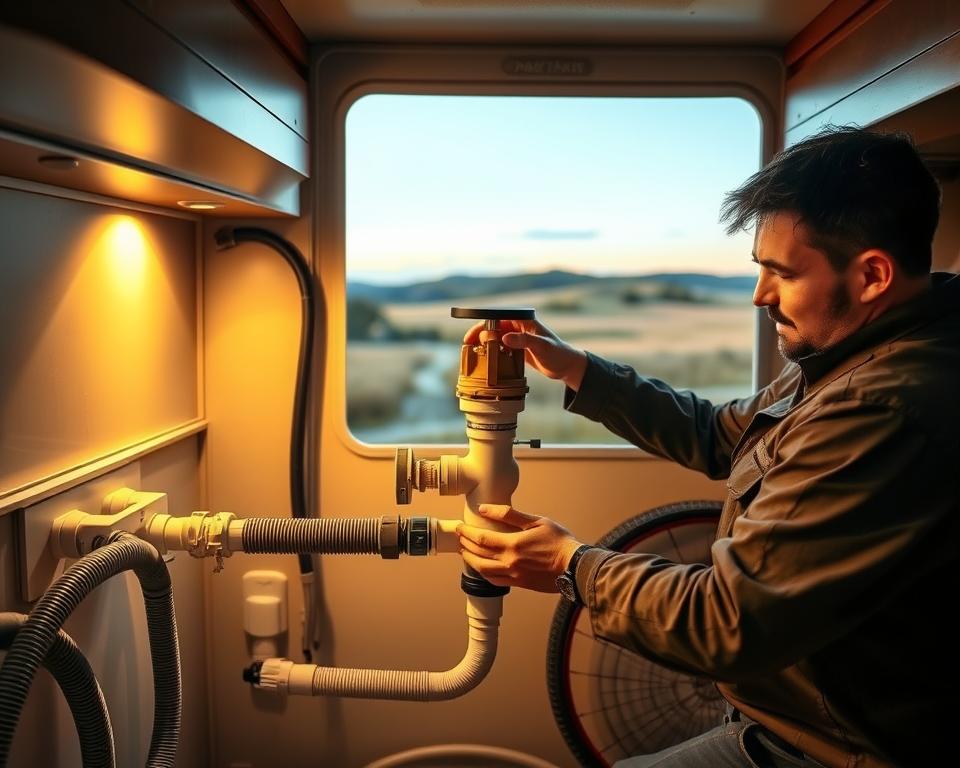RV Septic Tank Pumping: Essential Maintenance Tips
Consider the consequences of neglecting your RV’s septic system. Numerous campers feel intimidated by tank draining. Yet, recognizing the need for regular servicing is crucial. These steps preserve your camping joy and avoid expensive repairs. Learning proper waste disposal is key to your septic health. We’ll share vital insights on RV septic service near me, including best practices and tips to keep your system running smoothly.
Understanding Your RV Septic System
Your RV includes tanks designed for different wastes. It consists of a black tank for toilet use, a gray tank for sinks/showers, plus a freshwater reservoir. Knowing these components prevents clogs and ensures efficient cleaning.
A series of drain lines and vent pipes balance waste flow and airflow. A good grasp prevents clogs and nasty odors. This knowledge ensures hassle-free trips and reliable waste handling.
Maintaining clear, working tanks requires routine effort. Frequently checking tank levels and emptying on time preserves comfort. By maintaining your RV’s septic system properly, you’ll improve its lifespan and enjoy every trip more.
The Value of Consistent Septic Maintenance
Frequent tank pumping keeps your system working and clean. Leftover solids lead to smells and clogs, spoiling your trip. A full tank can produce embarrassing backups. These incidents mar your travel enjoyment.
Skipping pump-outs leads to pricey repairs. Damage from neglect can shorten component lifespan. Timely emptying keeps your plumbing running smoothly. It prevents unwelcome surprises and roadside emergencies.
Staying on top of maintenance wards off backups. Dedicating effort to pumping reflects good RV stewardship. It greatly improves your travel experience. A strict pumping routine lets you enjoy camping without septic concerns.
How Often Should You Pump Your RV Septic Tank?
Timing your tank dumps depends on several variables. Generally, dump every 3–5 days when in use. Still, it varies with tank size and occupancy. Pinpointing the correct dump time is key for effective wastewater management.
Dump the black tank at about two-thirds capacity. It ensures good drainage and cuts down on odors. Ignoring it can cause backups and unpleasant odors.
Many elements can affect how often you pump:
- Number of people on board
- Length of stay
- Type of waste generated
- Tank capacity
Planning is key to avoiding emergencies. Remember portable toilet service schedules. Knowing your patterns predicts when to dump.
| Usage Scenario | Pumping Frequency |
|---|---|
| Weekend Getaway (2 people) | Every 3–4 days |
| Extended Trip (4–6 people) | Every 2–3 days |
| Seasonal Use, Two to Four Campers | Weekly or Bi-Weekly |
Keep a close eye on tank levels and your habits. Staying attentive guarantees a pleasant trip.

Top Methods for Emptying Your Tanks
Correct dumping preserves system health and prevents issues. Always empty the black tank first to protect the gray tank. This prevents dirty water from fouling the clean.
Using a high-quality hose minimizes leaks and ensures smooth dumping. Secure all fittings firmly to avoid leaks. After emptying, flush the black tank with plenty of water. This removes residue and preps the tank for next time.
Scout dump spots along your route. This preparation streamlines your dump routine.
In short, follow these key steps for efficient dumping:
- Empty the black water tank first.
- Use a top-quality sewer hose.
- Flush the black tank thoroughly after emptying.
- Plan your dump station locations.
These tips refine your waste disposal process.
Tank Handling and Upkeep Best Practices
Grasping correct handling of black and gray tanks ensures system health. Maintain a bit of water in the black tank to aid waste decomposition.
Don’t flush wipes, feminine products, or paper towels. Always use RV-safe toilet paper to prevent clogs. Regular checks spot leaks or cracks before they worsen.
Occasional treatments boost system performance. They introduce microbes that digest solids effectively. Simple steps ensure smooth tank operation.
- Check for leaks and damage often.
- Apply RV-specific chemical treatments.
- Keep vents clear to avoid odors.
Following these rules protects your septic setup. It also boosts your camping enjoyment.
Essential Pumping Tips
To pump your tank effectively, follow a methodical approach. Proper disposal prevents issues—only dump at approved stations. Know your tank’s capacity to avoid overflows.
Monitoring levels guides your dump schedule. Routine scheduling preserves your septic system and travel enjoyment. A planned maintenance routine keeps everything running smoothly.
Rinse tanks thoroughly post-dump. It ensures each dump is cleaner than the last. By applying these strategies, you’ll maintain your RV’s condition and comfort.
Avoid These Septic System Errors
Upkeep prevents trip interruptions. Not using enough water in the black tank leads to buildup. Adequate water use breaks down solids efficiently.
Wrong flushables cause havoc—never flush wipes or towels. Only biodegradable RV-safe items belong in the black tank. Such mistakes can damage plumbing and inflate repair bills.
Leaving the black valve open too early is a mistake. Premature opening prevents a full flush. Only open when ready to empty for a complete clean.
Awareness of these errors boosts system longevity. Avoiding them keeps your waste management reliable.
When to Seek Professional Septic Services
Knowing when to hire pros preserves system health. Persistent odors often indicate complex issues. Slow drains point to potential clogs or buildup.
Waste spillage near dump sites signals trouble. Such situations usually need high-pressure cleaning. Pros blast away blockages to restore smooth flow.
Regular expert check-ups safeguard tank health. Acting on findings quickly prevents bigger problems. Hiring qualified technicians saves time and money long term.
Long-Term Maintenance for Your RV Wastewater Management
Smart upkeep ensures lasting system performance. Scheduled dumps preserve longevity and operation. Routine rinses clear residue and stave off expensive breakdowns.
Adopting sanitation routines protects your system. Inspecting connections stops leaks before they spread. Choosing eco-friendly treatments avoids damage.
Consider these long-term practices:
- Stick to a pump-out timetable.
- Rinse often to remove solids.
- Sanitize twice a year.
- Inspect parts frequently for wear and tear.
Investing in prevention brings peace of mind. Routine service lets you focus on the scenery, not your sewer.
Final Thoughts
Good septic care ensures enjoyable trips. Knowing system function and cleaning steps stops issues. Regular black tank maintenance improves efficiency. This makes your journey more comfortable.
By regularly checking and properly caring for your septic setup, you’ll ensure worry-free travel. Dependable sewage service backs every adventure. Adopting these habits keeps your RV ready to roll. Thus, you can concentrate on adventures rather than septic concerns.

